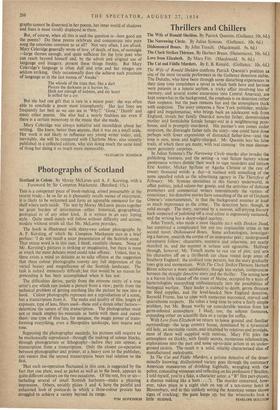Photographs of Scotland
This is a competent piece of book-making, aimed presumably at the tourist trade. - In so far as it pleasantly recalls scenes of enjoyment, it is likely to be welcomed and form an agreeable memento' for the shelf where such reside. The text by Moray McLaren pieces together no groat burden of information either historical, geographical, geological or of any other kind. It is written in an easy loping style. Quite small minds will follow without difficulty and accom- modate without strain all that Mr. McLaren provides.
The book is illustrated with thirty-two colour photographs by A. F. Kersting, of which Sir Compton Mackenzie says in a brief preface: 'I do not recall a nicer presentation of the Scottish scene.' That otiose word is in this case, I think, carefully chosen. None of Mr. Kersting's pictures is striking or imaginative, but there is none at which the most delicate mind could take offence. Unless, that is, there exists a mind so delicate as to take offence at the suggestion that these colour photographs convey any full impression of the varied beauty and magnificence of the Scottish landscape. The task is indeed immensely difficult; but that would be no reason for pretending it has been accomplished when it has not.
The difficulties derive, partly from the extreme rarity of a true artist's eye which can isolate a picture from a view; partly from the technical problem of getting anything like the picture he saw into a book. Colour photographs represent not a reproduction of a scene, but a transcription from it. The make and quality of film, length of exposure, type of lens, filters used—these and a dozen other factors— determine the nature of this transcription. The photographer must not so much employ his materials as battle with them and outwit them: one type of film has, for instance, the magic power of trans- forming everything, even a Shropshire landscape, into mauve and rose.
Supposing the photographer succeeds, his pictures still require to be mechanically reproduced—through the making of colour blocks, through photogravure or lithography—before they can appear, a transcription from a transcription. Only the closest co-operation between photographer and printer, at a heavy cost to the publisher, can ensure that the second transcriptiOn bears real relation to the first.
That such co-operation fluctuated in this case, is suggested by the fact that one plate, used as jacket as well as in the book, appears in quite different colours on the two occasions. Of the rest, five or six— including several of small Scottish harbours—make a pleasing impression. Others, notably plates 3 and 4, have the painful and exhausted look of postcards in which a three-colour process has struggled to achieve a variety beyond its range.
TOM HOPKINSON


































 Previous page
Previous page